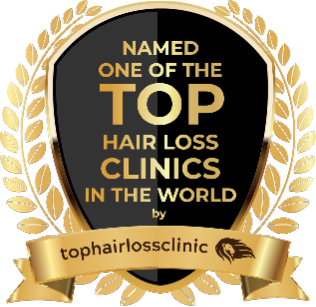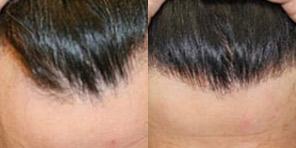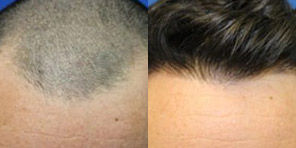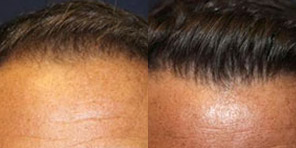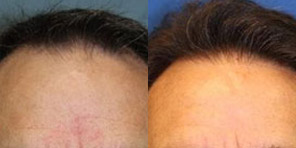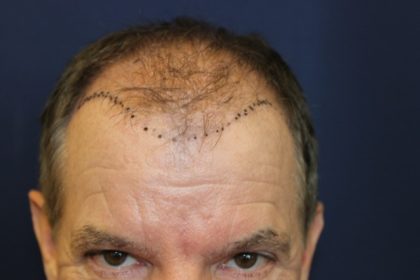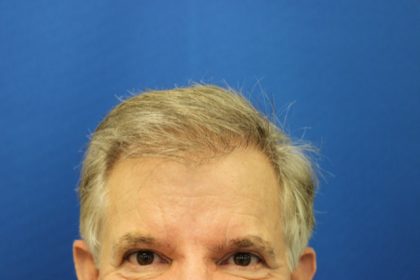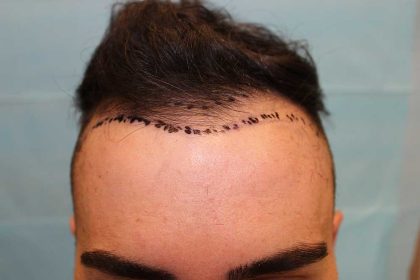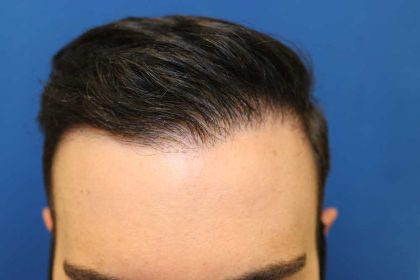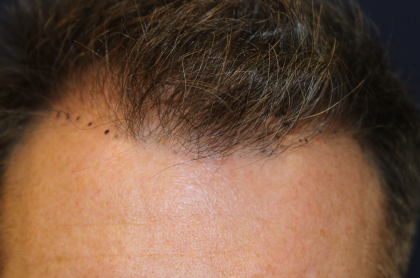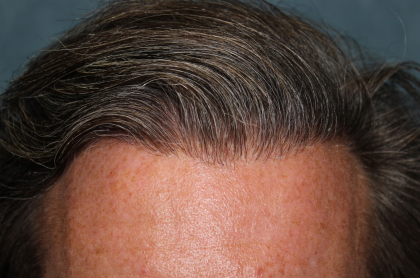Non-Surgical Hair Restoration
Consultations offered at our four convenient locations in La Jolla, San Diego, Newport Beach and Beverly Hills

Non-surgical hair restoration is a collection of treatments designed to rejuvenate and restore the thickness and appearance of hair without the need for surgery. These treatments for hair loss are widely available and can be highly effective in the right patients. Non-surgical treatments allow patients to delay more invasive procedures and avoid missing work or events. Your unique treatment plan may include topical or oral medications, injections, or aesthetic treatments to hide hair loss and stimulate new hair growth.
Drs. Richard Chaffoo and Susan Stuart understand how important one’s hair is to their confidence, identity, and personal expression. If you want to regain your confidence with a fuller head of hair, do not hesitate to schedule a consultation at California Hair MD. We are leading experts in the hair regeneration field and can help you achieve the results you desire. If you have any other questions about our practice, hair health and restoration, our team, or more, please call one of our offices and speak with our knowledgeable staff.
To reach our San Diego, La Jolla, Newport Beach, or Beverly Hills locations, please call (800) 373-4773. To reach our Corona Del Mar location, please call (877) 942-2644.
Contents
- 1 Before and After Photos
- 2 About Hair Loss
- 3 Why Should I Choose California Hair MD For Hair Loss Treatments?
- 4 Non-Surgical Hair Loss Treatments
- 5 Benefits
- 6 Candidates
- 7 Personal Consultation
- 8 Corresponding & Complementary Procedures
- 9 Cost of Hair Restoration Treatments in Southern California
- 10 FAQ
- 11 References
Before and After Photos
About Hair Loss
Androgenic alopecia is the medical term for the process of balding. Natural shifts in hormones like dihydrotestosterone and other compounds like 5-alpha-reductase lead to the shrinking of hair follicles and shortened regenerative cycles. This, combined with other factors like pollution, ultraviolet exposure, stress, genetics, and more causes our skin quality to decrease as we age and also leads to hair loss over time. (1) Androgenic alopecia is much more common in men than it is in women, with about 67% of male patients experiencing some degree of balding and about 24% of female patients experiencing the condition. (2)
Hair is one of the most defining features of a person’s identity. Everyone feels confident with healthy hair and can sculpt it to their own unique style. Seeing a slow thinning in hair can lead to decreased confidence and self-esteem. In men, balding is very often the subject of jokes. There are many different procedures available to help patients restore their hair to its former glory. Surgical hair transplants like follicular unit extractions (FUE) are incredibly effective and yield effective results for patients. However, not everyone can spare the time to undergo and recover from a surgical hair restoration procedure. Additionally, some patients respond to non-surgical methods with tremendous success, especially those whose hair loss is not at a level where it requires surgery.
California Hair MD helps patients at every stage of hair loss. Whether you are just starting to thin or have a significant loss, our experts can help you find effective solutions. From medications to non-surgical treatments or hair transplantation, we offer the latest treatments to restore your hair and revitalize your appearance.
Why Should I Choose California Hair MD For Hair Loss Treatments?
California Hair MD specializes in hair restoration and is one of the most trusted centers for hair restoration in the U.S. We are the first hair loss center in the USA under the direction of both a board certified dermatologist and a triple board certified plastic surgeon to provide our patients with the latest medical information about medications and surgical hair loss treatments. Since we have a board-certified dermatologist available, our patients have access to many medical treatments that may be unavailable at other hair restoration practices. America’s First Triple Board Certified Hair Transplant Plastic Surgeon, Dr. Chaffoo board-certified plastic surgeon can offer all state of the art hair transplantation services, including NeoGraft® and ARTAS®, to patients who need it.
Non-Surgical Hair Loss Treatments
Finasteride
Finasteride is an FDA-approved treatment for androgenic alopecia in men. It operates by targeting and inhibiting the 5-alpha-reductase enzymes that facilitate the conversion of testosterone to dihydrotestosterone, which is responsible for hair thinning and loss. Finasteride is administered orally in either 1-milligram or 5-milligram doses. The rate at which you take each dose will vary depending on the severity of your hair loss. (3)
Scalp Micropigmentation
Scalp micropigmentation is a form of cosmetic tattooing that can help create an appearance of fuller hair in a patient. By adding pigment to the scalp using a stippling pattern, cosmetic tattoo specialists can create the illusion of short hair growth, similar to that of a buzz cut. This treatment works very well for men who experience balding but has drawbacks for patients who are accustomed to wearing their hair longer. Micropigmentation is not limited to the scalp, either. Facial hair and eyebrows can be enhanced with this method as well. (4)
Minoxidil
Minoxidil is a topical medication option for hair restoration and slowing hair loss that has shown tremendous success with patients. It was originally developed as an oral medication to treat hypertension and lower blood pressure, but its methods in treating these issues have given it strong benefits for hair growth. It is now offered as both a topical solution and oral medication to stimulate hair growth. (5)
Minoxidil has been the industry standard for hair growth for many decades because of its effective results. However, because of its blood-pressure-reduction effects, some patients may not be able to use this treatment if their base blood pressure is already low. These cases are rare though, and many patients have been able to see benefits with minoxidil.
Low-Level Light Therapy
Low-level light therapy (LLLT) or low-level laser therapies have recently proven to be effective at enhancing the effects of hair-regenerative medication regimens. These treatments use photobiomodulation to stimulate hair growth. (6) Activity is increased in skin and hair cells when they are exposed to certain light wavelengths, and this prompts these cells to enter their growth phases. When combined with medication, this cell stimulation leads to effective hair growth for patients.
Platelet-Rich Plasma
Platelet-rich plasma, or PRP, is a treatment method that uses blood plasma containing high levels of platelets to stimulate hair growth. This is accomplished by supporting cell functions with extra nutrients and increasing the release of growth factors like platelet-derived endothelial growth factor (PDGF), fibroblast growth factor-2 (FGF-2), and others. (7)
Supplements
Various supplements and nutraceutical compounds have also been shown to improve hair growth and enhance results when combined with other treatment methods. (8) Many of these supplements contain phytochemicals, which are plant-derived biologically active compounds that have different effects on the body. Nutrafol is one of the most popular supplements available for hair growth. It contains curcumin, piperine, ashwagandha, saw palmetto, tocotrienols, and other beneficial plant-based ingredients that all help to stimulate cell growth, improve cell health, reduce cortisol levels, produce amino acids, and reduce inflammation. Viviscal is another popular supplement and uses compounds derived from sustainably sourced mollusk and shark powders, as well as other plant-derived ingredients. It has similar effects to Nutrafol but has also been shown to improve skin elasticity and thickness while stimulating hair growth. (8)
Other Treatments
Another medication that has shown success with patients is ketoconazole. Originally developed as an antifungal medication, ketoconazole reduces the levels of dihydrotestosterone present in the body. In doing so, a side effect is slowed hair loss and even hair regrowth. (9)
Spironolactone is another medication that has shown promising results for hair growth. Most hair regeneration medications are targeted toward men, but spironolactone is one of the most effective for female patients experiencing balding through female pattern hair loss (FPHL) and androgenic alopecia. (1)
Benefits
Non-surgical hair restoration treatments can help you regain your confidence and rejuvenate your hair without the complex techniques and recovery steps that are involved in surgical methods. Drs. Chaffoo and Stuart’s patients typically experience benefits like:
- Simple treatments: Your treatment may come in the form of pigmentation techniques, oral or topical medications, injections, or others. These are simple, quick procedures that do not require surgical techniques.
- No recovery time: You will not have to pause your life to spend time recovering if you are not receiving a surgical procedure.
- Healthy, natural results: As your treatments take effect, you will see your hair regrow with a healthy scalp and a natural-looking appearance.
- Increased happiness: Seeing your hair return will help you feel happier not only with your appearance but with your life overall.
- Affordability: Non-surgical hair restoration treatments may be more cost-effective than surgical procedures.
Candidates

If you are experiencing hair loss, surgery may not be your only treatment option. Patients who want to avoid surgeries are usually great candidates for these treatments, but they are also effective for patients whose balding is not very severe or is only just beginning. If you want to see an improvement in your hair, then please schedule a consultation appointment with either Dr. Chaffoo or Dr. Stuart.
Personal Consultation
When you meet with one of our board-certified doctors to discuss your treatment plan, you will first discuss the history of your hair loss. You will also discuss what you would like to accomplish with your hair restoration treatments. With this information, Dr. Chaffoo or Dr. Stuart will plan a treatment for you. If your treatment involves medications, you can expect multiple follow-up appointments to monitor the results.
In addition to discussing your goals and treatment plan, your medical history will also be reviewed. This is done to eliminate any risk of allergic reactions to any of the hair restoration medications.
Corresponding & Complementary Procedures
Dr. Chaffoo or Dr. Stuart will recommend a personalized, non-surgical treatment to complement surgical procedures. They may use these methods to extend hair transplantation results or reduce shedding. Dr. Chaffoo specializes in follicular unit extraction (FUE) hair transplantation with multiple devices including NeoGraft and ARTAS. This procedure harvests individual hair follicles and carefully places them onto your scalp to repopulate it and allow for healthy, thick hair growth.
Cost of Hair Restoration Treatments in Southern California
The cost of your treatment will depend on your individualized plan. When you meet with either Dr. Chaffoo or Dr. Stuart for your consultation, you will receive an accurate estimate. Additionally, if you have any questions about payments, pricing, or anything else, please do not hesitate to call (800) 373-4773 to get the information you need.
FAQ
Are non-surgical hair restoration treatments long-lasting?
Non-surgical treatments for hair loss can be highly effective in many patients. Many of our patients use non-surgical options to extend and maintain the results from hair transplantation or to delay surgical treatments until hair loss is more advanced. Once we have created your customized treatment plan, we can help you understand how long these options may work for you.
When should I start non-surgical hair restoration?
Non-surgical treatments for hair loss are most effective when they begin early. By the time you have noticeable hair loss, you may have already lost 50% of the hair in that area. If you are noticing changes in your hair, hairline, or loss patterns, see a hair loss specialist as soon as possible. Non-surgical treatments may be able to halt or slow hair loss.
Can women receive non-surgical hair loss treatments?
Non-surgical hair loss treatments are popular with our female and male patients alike.
Will I need downtime after non-surgical hair loss treatments?
Most non-surgical treatments for hair restoration require little to no downtime. Many times, these treatments are topical or oral medications you can use as part of your daily life to slow hair loss progression. Side effects are minimal and do not typically interfere with the ability to work, exercise, or participate in other activities. If you will need any recovery time after your treatment, we will let you know beforehand so you can plan for time off work.
References
- Nestor MS, Ablon G, Gade A, Han H, Fischer DL. Treatment options for androgenetic alopecia: Efficacy, side effects, compliance, financial considerations, and ethics. Journal of Cosmetic Dermatology. 2021;20(12). doi:https://doi.org/10.1111/jocd.14537
- Zito PM, Raggio BS. Hair Transplantation. PubMed. Published 2021. https://www.ncbi.nlm.nih.gov/books/NBK547740/
- Zito PM, Bistas KG, Syed K. Finasteride. PubMed. Published 2021. https://www.ncbi.nlm.nih.gov/books/NBK513329/
- Rassman WR, Pak JP, Kim J, Estrin NF. Scalp Micropigmentation. The Journal of Clinical and Aesthetic Dermatology. 2015;8(3):35-42. https://www.ncbi.nlm.nih.gov/pmc/articles/PMC4382144/
- Suchonwanit P, Thammarucha S, Leerunyakul K. Minoxidil and its use in hair disorders: a review. Drug Design, Development and Therapy. 2019;Volume 13:2777-2786. doi:https://doi.org/10.2147/dddt.s214907
- Pillai J, Mysore V. Role of low-level light therapy (LLLT) in androgenetic alopecia. Journal of Cutaneous and Aesthetic Surgery. 2021;14(4):385. doi:https://doi.org/10.4103/jcas.jcas_218_20
- Paichitrojjana A, Paichitrojjana A. Platelet Rich Plasma and Its Use in Hair Regrowth: A Review. Drug Design, Development and Therapy. 2022;Volume 16:635-645. doi:https://doi.org/10.2147/dddt.s356858
- Ring C, Heitmiller K, Correia E, Gabriel Z, Saedi N. Nutraceuticals for Androgenetic Alopecia. The Journal of clinical and aesthetic dermatology. 2022;15(3):26-29. https://www.ncbi.nlm.nih.gov/pmc/articles/PMC8944288/
- Aldhalimi MA, Hadi NR, Ghafil FA. Promotive Effect of Topical Ketoconazole, Minoxidil, and Minoxidil with Tretinoin on Hair Growth in Male Mice. ISRN Pharmacology. 2014;2014:1-5. doi:https://doi.org/10.1155/2014/575423

